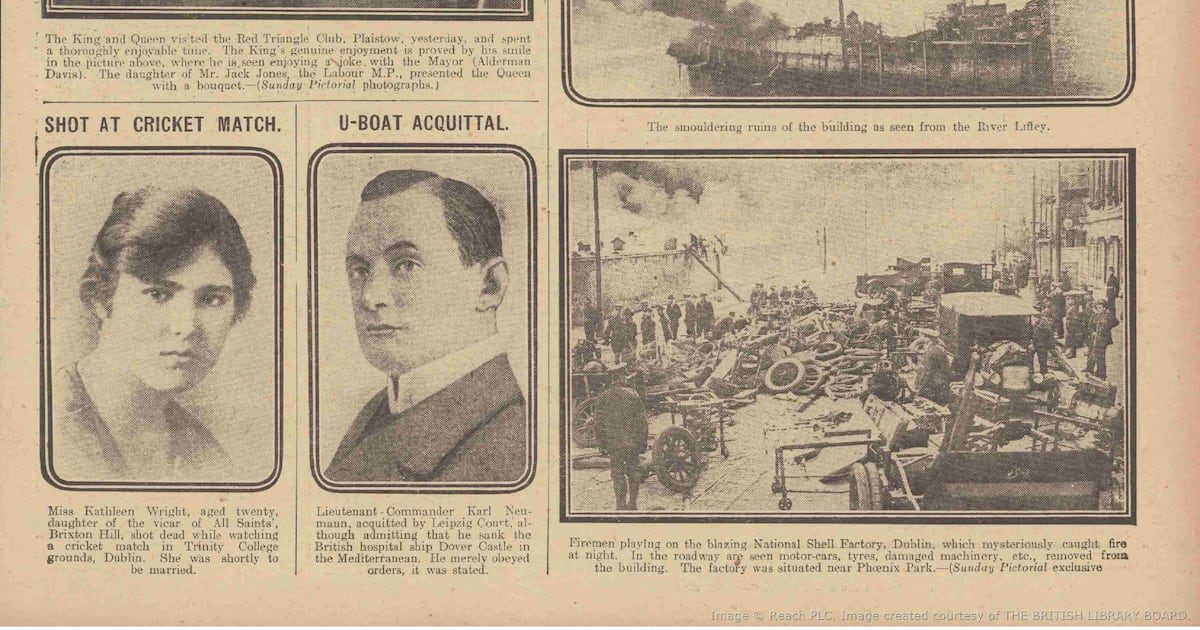Entertainment
Tragic Shooting of Trinity Student During War of Independence

On June 3, 1921, during a charity cricket match at Trinity College Dublin, arts student Kathleen Alexanderson Wright was fatally shot, marking a poignant moment in the Irish War of Independence. At just 21 years old, Wright’s life came to a tragic end, leaving a lasting impact on both her family and the university community. Her fiancé, George Herbert Ardill, was by her side when the shooting occurred, only realizing the severity of the situation when he heard her faint moans.
Ardill recalled, “I opened the coat which she was wearing at the time and then I noticed blood on the front of her blouse.” Despite the immediate response from bystanders, including three men claiming to be doctors, Wright was pronounced dead on arrival at Sir Patrick Dun’s Hospital. The shooting took place around 17:20, and the cricket match was abandoned shortly thereafter, as the reality of violence during the War of Independence struck home for many students.
Context of the Shooting
The cricket match, which pitted the Gentlemen of Ireland against members of the British military, was meant to raise funds for Great War veterans. As it unfolded, Pádraig Ó Conchubhair, an IRA member, later testified about his involvement in the incident. He and fellow IRA member Jimmy McGuinness had been ordered to halt the match, considering it a symbol of British presence in Ireland. Ó Conchubhair recounted, “After the first couple of rounds were fired, a lady spectator jumped up from one of the seats and got killed by a stray shot.”
Despite the chaotic aftermath, including a lack of immediate accountability for the shooting, the incident underscored the tension surrounding Ireland’s quest for independence. In the months leading up to the Truce in July 1921, violence and disorder were at their peak, with June of that year witnessing the highest casualties for both military and police forces.
Wright’s death received scant media coverage, with only a brief mention in the Lurgan Mail. Yet, it resonated deeply within the student body at Trinity College, with one student reflecting a year later that her tragic death “marked a closed chapter on the carefree days” of university life.
Aftermath and Historical Significance
Following her death, an inquiry was held to investigate the circumstances surrounding the shooting. This inquiry, led by Captain EJ Earle, determined that Wright died from “shock and haemorrhage caused by gunshot wounds inflicted by some person or persons unknown.” Despite this conclusion, no one was ever held accountable for her death.
The inquiry included testimonies from witnesses such as Ardill and Dr William Bernard Pemberton, who had pronounced Wright dead. However, the investigation failed to delve deeper into the identities of the shooters or the broader implications of the incident, leaving many questions unanswered.
From archival research, it emerged that Wright’s family was profoundly affected by her untimely demise. Her father, Rev Ernest Alexanderson Wright, sought compensation for the funeral costs, which amounted to more than £131, a significant sum for a man of his modest means. He expressed in a letter that his daughter had plans for her future, intending to work and repay her father for her education.
Wright’s experience as a female student at Trinity College was noteworthy; she was among the first generation of women to attend the institution. Admitted in 1904, women comprised approximately 15 percent of the student population by the early 1920s. Wright lived in Trinity Halls, located four kilometers from the college, as female students were not permitted to reside on campus.
Despite her promising future and the tragic circumstances surrounding her death, Wright’s story has largely been forgotten. There are no memorials or plaques commemorating her at Trinity College, contrasting sharply with the recognition given to others involved in the conflict. This absence highlights a broader narrative about the representation of women’s experiences during periods of political turbulence.
As Ireland continues to reflect on its history, the story of Kathleen Alexanderson Wright serves as a reminder of the human cost of conflict and the need for recognition of those who were affected by the violence of the War of Independence. The silence surrounding her death speaks volumes about the challenges of remembering and honoring the lives lost in pursuit of freedom.
-

 Top Stories3 months ago
Top Stories3 months agoTributes Surge for 9-Year-Old Leon Briody After Cancer Battle
-

 Entertainment4 months ago
Entertainment4 months agoAimee Osbourne Joins Family for Emotional Tribute to Ozzy
-

 Politics4 months ago
Politics4 months agoDanny Healy-Rae Considers Complaint After Altercation with Garda
-

 Top Stories4 months ago
Top Stories4 months agoIreland Enjoys Summer Heat as Hurricane Erin Approaches Atlantic
-

 World5 months ago
World5 months agoHawaii Commemorates 80 Years Since Hiroshima Bombing with Ceremony
-

 Top Stories3 months ago
Top Stories3 months agoNewcastle West Woman Patricia Foley Found Safe After Urgent Search
-

 Top Stories5 months ago
Top Stories5 months agoFianna Fáil TDs Urgently Consider Maire Geoghegan-Quinn for Presidency
-

 World5 months ago
World5 months agoCouple Convicted of Murdering Two-Year-Old Grandson in Wales
-

 World5 months ago
World5 months agoGaza Aid Distribution Tragedy: 20 Killed Amid Ongoing Violence
-

 World5 months ago
World5 months agoAristocrat Constance Marten and Partner Convicted of Infant Murder
-

 Top Stories4 months ago
Top Stories4 months agoClimbing Errigal: A Must-Do Summer Adventure in Donegal
-

 Top Stories4 months ago
Top Stories4 months agoHike Donegal’s Errigal Mountain NOW for Unforgettable Summer Views









